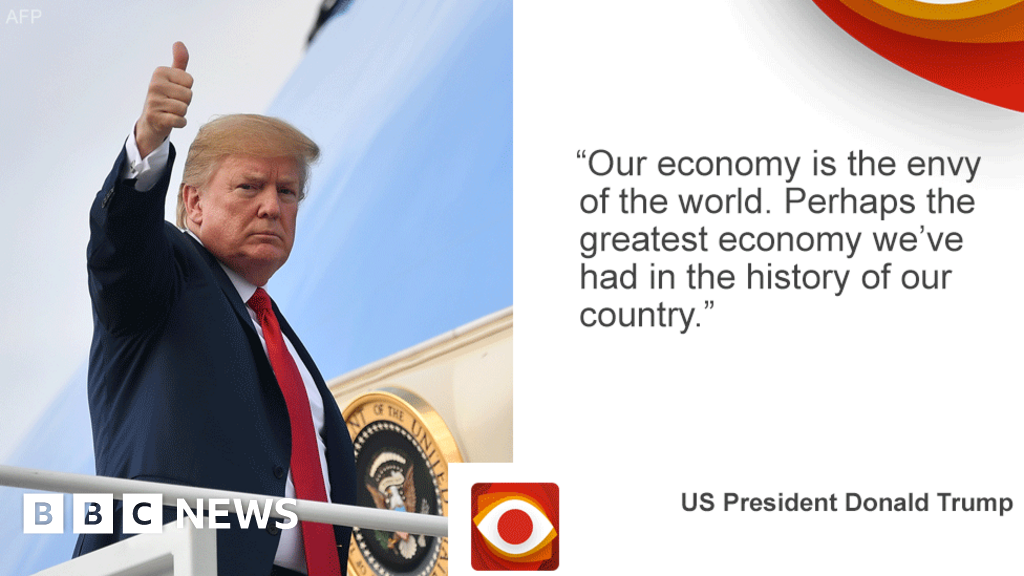US economy under Trump: Is it the greatest in history?
Is the US economy under President Trump the best it’s ever been? …


Claim: President Trump often says the US economy is on an historic high, perhaps the greatest it’s ever been.
Speaking at the UN General Assembly this month, he reinforced those claims by talking of how his “pro-growth economic policies” had helped Americans with jobs and wages.
Reality Check verdict: It’s true the economy has been doing well – but there have been periods when it was even stronger.
And the trade war with China, rising tensions in the Middle East and fears over the health of the global economy have unsettled markets recently, and led the US central bank, the Federal Reserve, to lower interest rates.
“Some of the best economic numbers our country has ever experienced are happening right now,” President Trump tweeted earlier this month.
What do the figures show?
The annual rate of growth in GDP – the value of goods and services in the economy – has generally been strong.
For 2019, the data shows a 3.1% growth for the first quarter, but this slowed to 2.1% in the second quarter (which ended in June).
This is significantly less than the 5.5% achieved in the second quarter of 2014 during the Obama presidency.
And if you go further back, there were times in the 1950s and 1960s when GDP growth was even higher.
“If you choose to look at the health of the economy based on GDP, Mr Trump’s claims are suspect when compared to the national economic boom of the post-War years,” says Megan Black, assistant professor of history at the London School of Economics.
Stock market soars… then wobbles
President Trump has highlighted the rising value of US financial markets – in particular the Dow Jones Industrial Average, which follows the shares of 30 major US companies.
It’s true the Dow reached record highs under his administration. Mr Trump’s supporters argue that his corporation tax cuts along with his US-focused policies, his clampdown on bureaucracy and his promises of infrastructure investment have all helped.
However, in recent months, the index has been highly volatile, reflecting worries about the trade confrontation with China, and a gloomier outlook for the global economy.
Jobs and wages
So, what’s happening with employment and wages?
In his speech to the UN General Assembly, President Trump said unemployment was at its lowest for half a century. He also said that in the last three years, six million more Americans were now on the employment role.
In August this year, the unemployment rate was 3.7%. Fifty years ago in September 1969, the unemployment rate was the same – 3.7%.
But it did drop to 3.5% in November and December 1969 so that’s actually the lowest point for fifty years.
As for the numbers in employment, it’s true that over six million more were recorded as employed in August 2019 compared with August 2016.
Mr Trump has also highlighted record low levels of unemployment amongst specific groups.
“Last month, African American, Hispanic American and Asian American unemployment reached the lowest levels ever recorded,” he said.
It’s correct that going by data from 1972 onwards, unemployment for African Americans was at a record low in August – at 5.5%.
US official data for Hispanic workers goes back to 1973, and in August this year, unemployment was at 4.2% – that’s also the lowest recorded level.
For Asian Americans, records only go back to 2003. These show the unemployment rate last month was 2.8% – the lowest ever recorded was actually in June this year when it was 2.1%.
In all these groups, unemployment levels had been decreasing throughout the Obama years, after peaking around the time of the 2009 recession.
President Trump also told the UN that “wages are rising, incomes are soaring.”
That’s not the whole story.
Average hourly earnings growth did continue throughout 2018 – a generally upward trend which began during President Obama’s administration.
It reached 3.4% in February this year, but then began slowing and is now at 3.23%.
In real terms after inflation is taken into account, wages increased by 1.5% between August 2018 and August 2019, according to official data.
Household income has also been growing – but the rate of increase slowed in the last few years.
In 2018, median household income was $63,179, which official data says is not statistically different from the previous year.
This was reported to be the first year it had barely moved after three years of growth.




